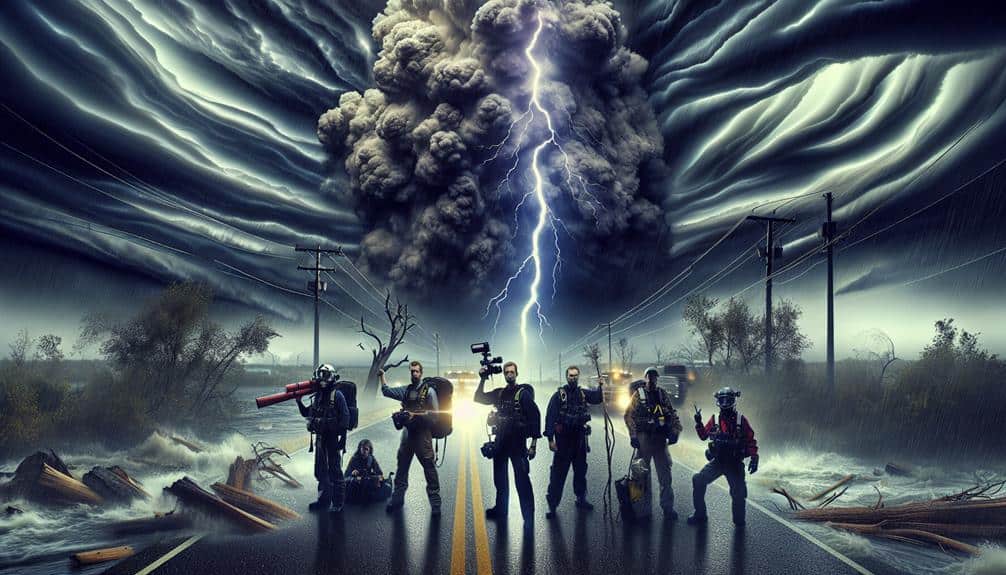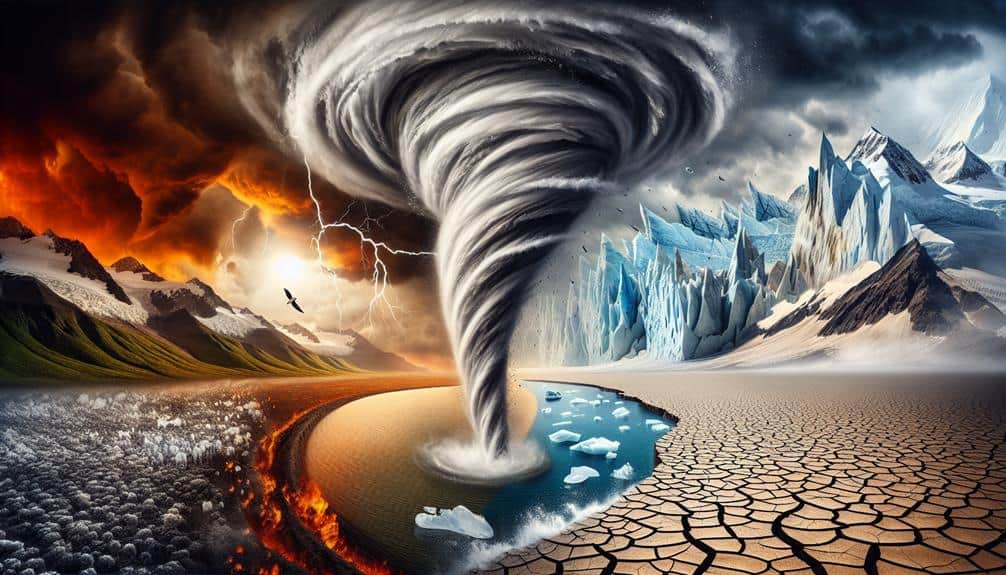Improving storm chasing success in a changing climate requires us to leverage advanced forecasting technologies and adapt our strategies. By analyzing historical climate data and using high-resolution satellite imagery and Doppler radar, we can track atmospheric conditions in real time. High-precision weather models help us make informed decisions about when and where to chase. We integrate dynamic risk assessments and machine learning algorithms to predict storm intensity and deviations. Ensuring safety involves using GPS mapping for route planning and maintaining clear communication with teams and local authorities. With these methods, we navigate the complexities of storm chasing more effectively, offering deeper insights.
Key Points
- Utilize high-resolution satellite imagery and Doppler radar for real-time tracking of atmospheric conditions.
- Integrate dynamic risk assessments and machine learning algorithms to predict storm intensity and deviations.
- Employ GPS mapping software with real-time traffic data for optimal route planning and multiple exit strategies.
- Maintain safety protocols, emergency gear, and constant communication with other chasers and local authorities.
Understanding Climate Patterns
Understanding climate patterns involves analyzing data from various sources to identify trends and anomalies that influence weather systems. We start by scrutinizing historical climate data, satellite imagery, and atmospheric measurements. These datasets help us pinpoint climate trends that reveal long-term changes in temperature, precipitation, and storm frequency. By examining these trends, we can better understand the environmental impacts that arise from shifting climate dynamics.
For instance, a rise in global temperatures can lead to more intense and frequent storms. We observe that warmer ocean waters fuel stronger hurricanes, while altered wind patterns may redirect storm paths. Such changes have significant environmental impacts, including coastal erosion, flooding, and habitat destruction. Our ability to track and interpret these patterns is pivotal for predicting storm behavior and improving our storm-chasing strategies.
Analyzing anomalies is equally important. These deviations from established norms can signal the onset of unusual weather events. By identifying these outliers, we can adapt our approaches to storm chasing, ensuring we're prepared for unprecedented conditions.
Through meticulous analysis of climate data, we gain the freedom to anticipate and navigate the complexities of our changing climate, enhancing both safety and success in our endeavors.
Advanced Forecasting Technologies
Advancements in forecasting technologies have revolutionized our ability to predict and respond to severe weather events with exceptional accuracy. We've harnessed satellite data and radar analysis to make significant progress in storm prediction, enabling us to get closer to the action and increase our chances of successful storm chasing.
Satellite data provides us with detailed, real-time views of atmospheric conditions. These high-resolution images help us track cloud formations, moisture levels, and temperature variations across vast areas. By analyzing this data, we can identify potential storm systems long before they develop into severe weather events, giving us a strategic advantage.
Radar analysis takes this a step further by offering detailed insights into storm structure and dynamics. Modern Doppler radar systems allow us to measure wind speeds and precipitation rates with remarkable precision. This information is essential for pinpointing the most intense parts of a storm, thereby enhancing our ability to predict its path and potential impact.
Combining satellite data with radar analysis, we can create highly accurate weather models. These models not only improve our forecasting capabilities but also enable us to make informed decisions on when and where to chase, maximizing both our safety and success.
Adapting Chase Strategies
Building on the precision offered by advanced forecasting technologies, we must adapt our chase strategies to effectively navigate the increasingly unpredictable nature of severe weather events. It's crucial that we integrate dynamic risk assessment into our approach. This means continuously evaluating storm intensity, potential hazards, and real-time atmospheric changes.
We should use high-resolution radar data and model outputs to predict storm evolution with greater accuracy.
Route planning becomes paramount in this adaptive strategy. We need to develop flexible plans that account for rapid changes in storm paths. By employing GPS mapping software and real-time traffic data, we can optimize our routes to stay ahead of the storm while minimizing exposure to dangerous conditions. It's necessary to identify multiple exit routes in case the storm's behavior changes unexpectedly.
Additionally, we should leverage machine learning algorithms that can analyze historical storm data to predict potential deviations in storm tracks. This allows us to preemptively adjust our chase routes.
Safety Considerations
When chasing storms, prioritizing safety is paramount to mitigate the inherent risks associated with severe weather events. We must implement thorough risk assessments before heading out. This entails evaluating weather forecasts, understanding storm dynamics, and identifying potential hazards in the chase area.
It's essential to have a clear understanding of escape routes and safe zones, ensuring we can quickly relocate if conditions worsen. Our vehicles should be equipped with necessary safety gear, including first aid kits, weather radios, and GPS devices. Emergency protocols must be established and rehearsed.
We need to know how to respond if we encounter flash floods, hailstorms, or tornadoes. This preparation isn't just about having the right tools; it's about understanding how to use them effectively under pressure. Communication is also crucial. Maintaining contact with other chasers and local authorities can provide real-time updates on weather changes and road conditions.
We should never chase alone; having a team increases our situational awareness and provides backup in emergencies.
Collaboration and Data Sharing

Successful storm chasing relies on strong collaboration and seamless data sharing among meteorologists, researchers, and chasers. Our achievements in the field are closely tied to integrating technology and nurturing research partnerships.
By utilizing real-time data and advanced forecasting models, we can make more informed decisions and improve predictive accuracy.
Data sharing is fundamental to these collaboration initiatives. Information must flow freely among academic institutions, government agencies, and independent chasers. This includes exchanging satellite imagery, radar data, and on-the-ground observations. The extensive datasets allow us to analyze storm patterns effectively and adjust strategies in real-time.
Technology integration is crucial for facilitating these efforts. Advanced communication tools and cloud-based platforms enable us to share insights instantly, regardless of our physical locations. Additionally, integrating machine learning algorithms can help identify trends and anomalies that might otherwise go unnoticed.
Frequently Asked Questions
How Do Storm Chasers Fund Their Expeditions?
We fund our storm chasing expeditions through a mix of crowdfunding campaigns and sponsorships. Additionally, we rely on personal savings and sometimes sell equipment. Independence is key, hence our diversified funding strategy guarantees flexibility and autonomy.
What Type of Vehicles Are Best for Storm Chasing?
Chasing storms is like taming a wild beast. We need trucks or SUVs with sturdy vehicle modifications and advanced safety equipment. These guarantee we can navigate harsh conditions safely and efficiently, giving us the freedom to explore.
How Can One Become a Professional Storm Chaser?
To become professional storm chasers, we need to complete specialized training programs and invest in quality equipment. Equipment costs can be high, but proper training guarantees we're prepared and safe, giving us the freedom to pursue our passion.
What Are the Most Common Misconceptions About Storm Chasing?
Many think storm chasing is just thrill-seeking, but it's not. We prioritize safety precautions and rely on precise equipment needs. Misconceptions also include underestimating the risks and overestimating the ease of predicting storm paths.
Are There Any Famous Storm Chasers Known for Their Successful Pursuits?
Yes, there are famous storm chasers like Reed Timmer and Josh Morgerman. They've gained recognition for their extreme weather pursuits, especially in Tornado Alley, using advanced technology to document and analyze severe storms precisely.


